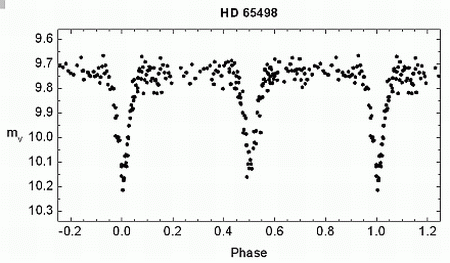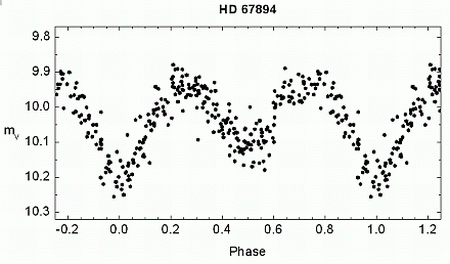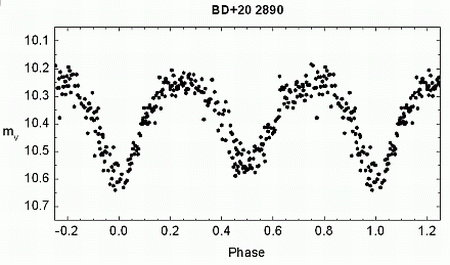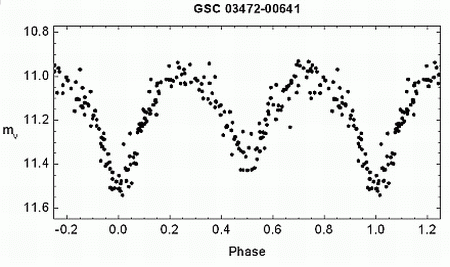FOUR NEW SHORT-PERIOD ECLIPSING BINARIES
Maciejewski, G., Niedzielski, A., Karska, A.
June 17, 2003
HD 65498
is recorded in Simbad
database as a star of V=9.75 mag with (B-V)=0.48 and
spectral type G. Our observations collected during 13 nights
between February 23, 2003 and April 4, 2003 and consisting of 232
data points show that HD 65498 is an algol-type
variable (EA) with period of about 31.5 hour. In the primary
minimum the observed brightness drops by 0.43 mag.
The secondary minimum is 0.05 mag shallower and appears exactly in
phase 0.5 indicating circular orbit of the system. Both minima are
of equal duration and last for about 4 hours.
|

CCD light curve of HD 65498
|
|
Variability of
HD 67894
was discovered during 23 nights between October 23, 2002 and April 10,
2002. 278 data points were collected in total. HD 67894 has
V=9.98 mag and (B-V)=0.40, and is classified as a star of
spectral type of G0 in Simbad. As it is seen in a figure below, the
difference between minima is considerable. The depth of the
primary minimum is 0.28 mag and an amplitude of the
secondary minimum is 0.18 mag. Therefore, despite of a short period
and a late spectral type, we classified the system basing on the
light-curve morphology as an eclipsing variable of Beta Lyrae
type.
|

CCD light curve of HD 67894
|
|
BD+20 2890
was noted as a variable star with
an amplitude about 0.2 mag by Oja (1985) during a photoelectric
UBV photometry survey for stars located near the North Galactic
Pole. The V magnitude for the star of interest is 10.4 and color
indices (B-V)=0.38 and (U-B)=-0.02. Our
photometric data show that BD+20 2890 is an
eclipsing binary of W UMa type changing its brightness with an
amplitude in the primary minimum by 0.37 mag and
with a period of just over a half of a day. The secondary minimum
is 0.07 brighter. Observations were performed during 14 nights
between April 21, 2003 and June 1, 2003. 309 single photometric
measurements were collected.
|

CCD light curve of BD+20 2890
|
|
GSC 03472-00641
is the last new variable presented in this news.
Photometry from to TYCHO-2 Catalogue gives
V=11.32 mag and (B-V)=0.45. Our 214 data points collected
during 12 nights between April 19, 2003 and May 7, 2003 show that
GSC 03472-00641 is a W UMa system with a period of almost 8 hours.
The obtained light curve is presented below. The primary and
secondary minima have an amplitude of 0.50 and
0.39 mag respectively.
|

CCD light curve of GSC 03472-00641
|
|
The full results with spectral classification were published in IBVS 5431 (compressed PostScript).
|

